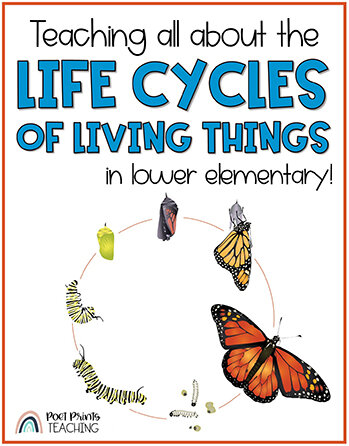Life Cycles of Animals and Plants: 6 Engaging Ideas
Spring is in the air, can you feel it? As the weather starts to warm up, and we start to thaw out a little bit up here in Canada, it’s the perfect time to think about our next set of science lessons. Spring is my favorite time to teach about life cycles because we can naturally observe them all around us. If teaching about the life cycles of living things is on your science lesson plans this spring, take a peek at six of my favorite ways to keep students engaged as we study how plants and animals grow and change.
Teaching all about the life cycles of living things in lower elementary. The life cycle of a butterfly is depicted.
1. Grow plants in the classroom
A student observes a bean plant and writes in a plant observation journal.
Study the life cycle of a plant in a hands-on way by planting a bean seed in a simple plastic cup in your own classroom. (You can read all about how we used inquiry-based science to grow and study our bean plants here!) Then, we use plant observation journals to make notes of the various stages of plant growth and track the growth on a simple graph (hello, math integration!). Watching students get excited about growing their own bean plant never gets old. I’ve done this activity year after year, and I’m always amazed at how many students decide to continue growing their bean plants at home.
Teach Plant & Animal Life Cycles Today!
Looking for a FAST way to plan out your life cycles unit that includes 2 full weeks of ideas? In just a few clicks you can grab all of the pieces you need: vocabulary, nonfiction reading, projects, activities, and more! Click and print. Planning is really that easy.
2. Set up a Student-Led Reading Station
Gather books about the life cycles of plants and animals and set them up in a reading station in your classroom. In a perfect world, these should be available from your school or district library, but your local library may also have titles available. Ask your students which plants and animals they are interested in! Give students time during silent reading or science to freely explore the books and learn more about the plant or animal of their choice.
3. Head outside and observe life cycles in your neighborhood.
If you are able, walk around your school property or neighborhood in the spring! Point out buds on trees, flowers, and things sprouting from the ground. Bring notebooks and pencils to sketch examples of living things and moments in the life cycle of a plant or animal.
4. Get hands-on with a life cycles project
Read about the different stages in the life cycle of a salmon and create a fun flipbook project to help students show what they’ve learned. It’s the perfect way to integrate non-fiction reading into your science lesson. This project is part of the complete Life Cycles of Living Things science unit for second grade.
5. Observe a Life Cycle
Observing a complete life cycle is such a fun way to get students engaged in science. This can be done in a few different ways:
We have even asked families with young pets to bring them in at different intervals so we could observe the changes. One year a family with a new puppy graciously brought it in 3-4 times for these observations!
6. Watch YouTube videos about the life cycle of animals
Sometimes videos can give students great visual representations about simple life cycles. Check out some of my favorites at a few different levels.
The Life Cycle of a Frog by Peekaboo Kidz (4 min)
The Life Cycle of a Butterfly by National Geographic, timelapse, no words (2 min)
The Life Cycle of a Salmon by National Geographic, narrated (3 min)
Text: Teaching all about the life cycles of living things in second and third grades.
Image: A child looks into a tank at an aquarium.





